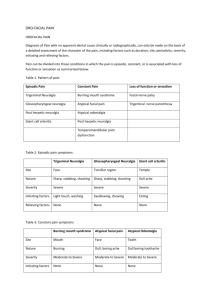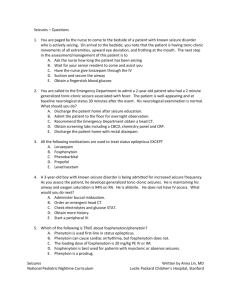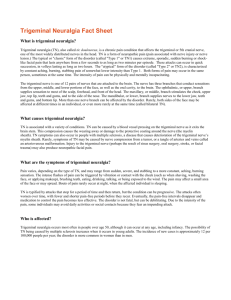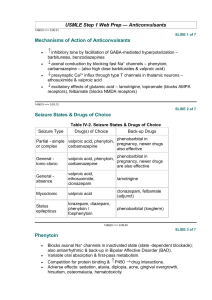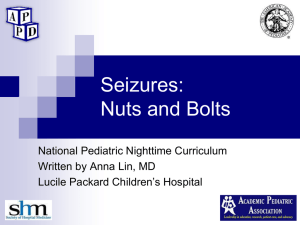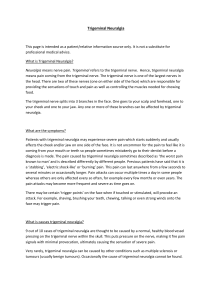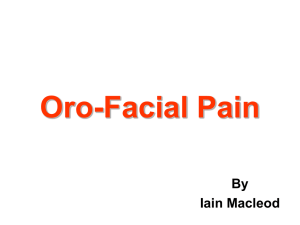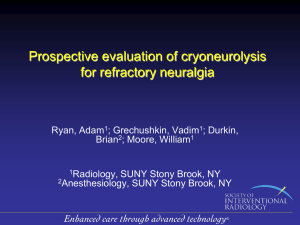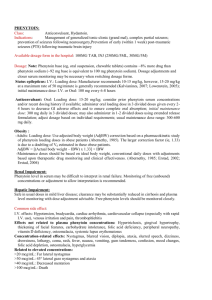Fosphenytoin: An Intravenous Option for the Management
advertisement
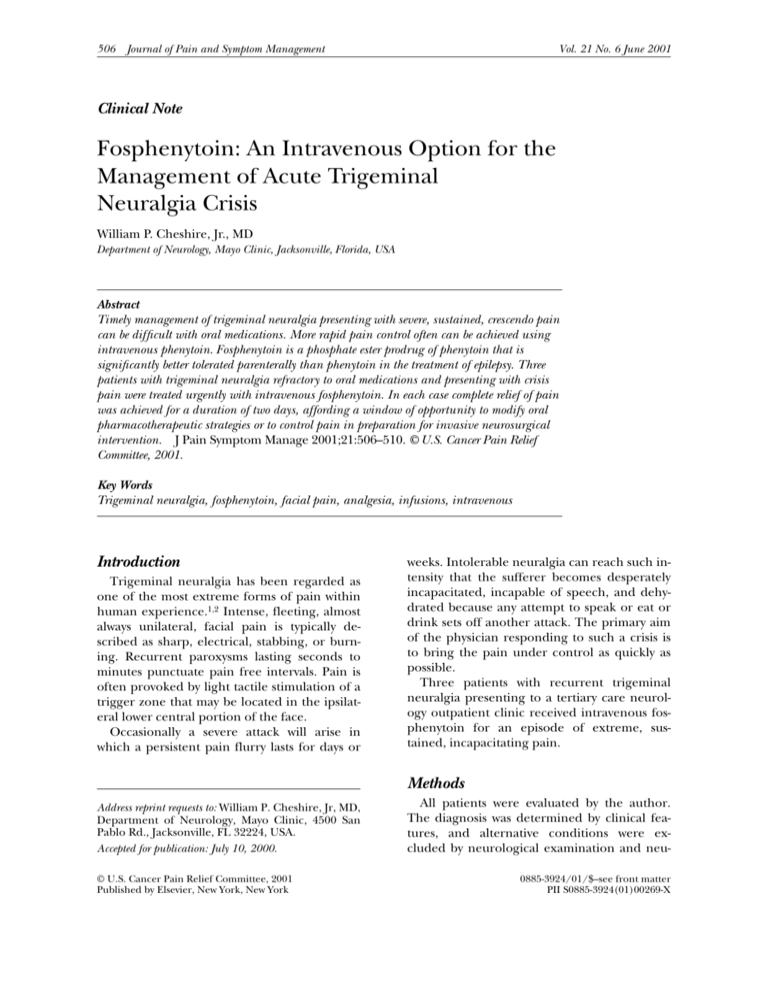
506 Journal of Pain and Symptom Management Vol. 21 No. 6 June 2001 Clinical Note Fosphenytoin: An Intravenous Option for the Management of Acute Trigeminal Neuralgia Crisis William P. Cheshire, Jr., MD Department of Neurology, Mayo Clinic, Jacksonville, Florida, USA Abstract Timely management of trigeminal neuralgia presenting with severe, sustained, crescendo pain can be difficult with oral medications. More rapid pain control often can be achieved using intravenous phenytoin. Fosphenytoin is a phosphate ester prodrug of phenytoin that is significantly better tolerated parenterally than phenytoin in the treatment of epilepsy. Three patients with trigeminal neuralgia refractory to oral medications and presenting with crisis pain were treated urgently with intravenous fosphenytoin. In each case complete relief of pain was achieved for a duration of two days, affording a window of opportunity to modify oral pharmacotherapeutic strategies or to control pain in preparation for invasive neurosurgical intervention. J Pain Symptom Manage 2001;21:506–510. © U.S. Cancer Pain Relief Committee, 2001. Key Words Trigeminal neuralgia, fosphenytoin, facial pain, analgesia, infusions, intravenous Introduction Trigeminal neuralgia has been regarded as one of the most extreme forms of pain within human experience.1,2 Intense, fleeting, almost always unilateral, facial pain is typically described as sharp, electrical, stabbing, or burning. Recurrent paroxysms lasting seconds to minutes punctuate pain free intervals. Pain is often provoked by light tactile stimulation of a trigger zone that may be located in the ipsilateral lower central portion of the face. Occasionally a severe attack will arise in which a persistent pain flurry lasts for days or weeks. Intolerable neuralgia can reach such intensity that the sufferer becomes desperately incapacitated, incapable of speech, and dehydrated because any attempt to speak or eat or drink sets off another attack. The primary aim of the physician responding to such a crisis is to bring the pain under control as quickly as possible. Three patients with recurrent trigeminal neuralgia presenting to a tertiary care neurology outpatient clinic received intravenous fosphenytoin for an episode of extreme, sustained, incapacitating pain. Methods Address reprint requests to: William P. Cheshire, Jr, MD, Department of Neurology, Mayo Clinic, 4500 San Pablo Rd., Jacksonville, FL 32224, USA. Accepted for publication: July 10, 2000. © U.S. Cancer Pain Relief Committee, 2001 Published by Elsevier, New York, New York All patients were evaluated by the author. The diagnosis was determined by clinical features, and alternative conditions were excluded by neurological examination and neu0885-3924/01/$–see front matter PII S0885-3924(01)00269-X Vol. 21 No. 6 June 2001 Intravenous Fosphenytoin for Acute Trigeminal Neuralgia Crisis roimaging studies. A diagnosis of trigeminal neuralgia required a history of recurrent episodes of paroxysmal, rather than continuous, unilateral facial pain distributed along one or more divisions of the trigeminal nerve. This series did not include patients with multiple sclerosis or postherpetic neuralgia. Concentration of fosphenytoin, a phosphate ester prodrug of phenytoin, is expressed as phenytoin sodium equivalents (PE) in order to avoid the need to perform molecular weight-based adjustments when converting from the more familiar phenytoin. In each case fosphenytoin was diluted to 5–10 mg PE/ ml in 5% dextrose with 0.45% NaCl and injected through an intravenous catheter. During the infusions hemodynamic parameters were continuously monitored by electrocardiogram (EKG) and sphygmomanometer. Results Case 1 A 66-year-old woman had suffered for 10 years from recurrent episodes of paroxysmal left mandibular pain described as sharp jabs or electrical shocks and triggered by touching the corner of the lip. Neurological examination and magnetic resonance imaging (MRI) of the brain were normal. Carbamazepine had, until recently, kept the pain under good control. Several difficult episodes had been successfully treated with carbamazepine in combination with baclofen. She presented with a two-week exacerbation of nearly continuous repetitive volleys of severe pain. Any attempt to open the mouth resulted in excruciating tic-like facial pain, making it impossible for her to speak. She was losing weight because the pain limited her diet to occasional sips of liquids. During the consultation she sat silently, cowering in distress. She answered questions in writing while holding her left hand near her face, daring not to touch it, and trembling with each surge of pain. A small ecchymosis on the lower face marked where she had vigorously applied ice packs, but to no avail. Increasing the dosage of carbamazepine beyond her current regimen of 200 mg three times daily had failed to relieve her pain but caused disorientation. The patient was treated with 0.9 g (18 mg/ kg) PE of fosphenytoin over 20 minutes. At the 507 completion of the infusion, in contrast to her former agony, her expression beamed with joy, and she was able to converse without any pain at all. She reported mild tinnitus and experienced some ataxia of gait so that she required assistance to avoid stumbling when departing the building. These side effects cleared by the following morning. Because a previous trial of oral phenytoin had proven ineffective, gabapentin 100 mg three times daily was added to the carbamazepine. She remained pain-free only two days. Severe pain returned and did not respond to increasing dosages of gabapentin. The patient opted to undergo a suboccipital craniectomy. Intraoperative inspection revealed significant indentation on the trigeminal nerve by the superior cerebellar artery superiorly and by a redundant loop of the internal carotid artery at the root entry zone. A microvascular decompression was performed. The patient has remained free of pain and off of medication for 2.5 years. Case 2 An 80-year-old man was seen for a 4-year history of paroxysmal, sharp, shooting or burning, right mandibular pain triggered by touching the lower lip, speaking, chewing, drinking, or swallowing. Periodic exacerbations were partially relieved by carbamazepine to dosages as high as 600 mg three times daily. Intervening remissions lasted weeks to months. Less effective medications had included gabapentin, tramadol, oxycodone, and hydrocodone. Neurological examination was remarkable for gait ataxia and peripheral neuropathy. MRI of the brain demonstrated tortuosity of the vertebrobasilar system. He presented with four days of the most severe exacerbation of pain he had ever experienced and which prevented any eating except for some sips of milk. An incremental dosing strategy was utilized with the rationale of administering the lowest fosphenytoin dosage necessary to control his pain. 100 mg PE of fosphenytoin was injected intravenously at intervals of 10 minutes with a planned maximum limit of 10 doses. Pain was reassessed qualitatively following each dose. Pain gradually improved during the infusions and fully resolved only after the final dose for a total of 1.0 g (11 mg/kg) PE. No hemody- 508 namic changes occurred. No side effects were reported. Although considered, phenytoin for followup oral therapy was avoided because of baseline gait ataxia. Instead, baclofen 10 mg three times daily was added to the carbamazepine 200 mg three times daily. Over the following day, the patient was so pleased by the complete absence of pain that, contrary to instructions, he stopped taking the carbamazepine. Approximately 20 hours later episodes of moderate pain returned and failed to respond to increasing dosages of carbamazepine and baclofen. Four weeks later the patient underwent percutaneous balloon compression of the trigeminal nerve. He has been free of pain and off medication for 7 months. Case 3 A 75-year-old woman was evaluated for a 5-month, nearly continuous exacerbation of a 14-year history of severe, paroxysmal, left lower facial pain described in terms of electricity, burning, or tingling. Touching the face, speaking, or exposure to wind resulted in pain intensification and radiation to the cheek. She was losing weight because for several weeks the pain had prevented her from eating more than tiny amounts of food. Neurological examination was remarkable for exquisite cutaneous sensitivity in the third division of the left trigeminal nerve. The patient appeared weary from pain and could hardly speak. MRI of the brain was unremarkable. A trial of phenytoin 7 years earlier had been ineffective. Carbamazepine had been quite effective at 200 mg twice daily, but recently had not helped, even when combined with baclofen 10 mg three times daily. The patient was unable to tolerate higher dosages due to cognitive side effects. The same incremental dosing strategy was applied as in Case 2. Ten doses of 100 mg were spread out over 3 hours, the dosing intervals being longer as limited by nursing availability. Following a total dosage of 1.0 g (14 mg/kg) PE, the pain had almost entirely ceased, and by the following morning she was pain free. No hypotension occurred. She reported mild dizziness upon standing after the eighth dose but did not have orthostatic hypotension. Thereafter, she was able to eat and speak freely and without pain. Cheshire Vol. 21 No. 6 June 2001 Two days later the pain returned intermittently despite increasing carbamazepine to 200 mg three times daily, adding phenytoin first at 100 mg twice daily and then three times daily to the point of ataxia. The pain then failed to respond to trials of lamotrigine, topiramate, or topical lidocaine, but was completely relieved by a Gasserian balloon compression procedure. The patient has been free from pain for three months. Discussion Trigeminal neuralgia, while characteristically poorly responsive to traditional analgesics such as opioids, is remarkably responsive to some anticonvulsants, particularly carbamazepine.3,4 In these three patients presenting with extremely painful, acute, sustained exacerbations of chronic recurrent trigeminal neuralgia, oral anticonvulsants alone had failed to relieve the pain. All three were already taking carbamazepine, and increasing the dosage in each case had been ineffective or not tolerated due to adverse side effects. Moreover, their condition required more urgent control of pain than would have been possible through manipulation of oral medications. Rapid attainment of a therapeutic concentration of carbamazepine, for example, by an oral loading dose is usually not possible due to unpleasant and difficult-to-manage transient side effects accompanying initiation of therapy.5 Several days in fact may be required after beginning oral anticonvulsant therapy before steady state pharmacodynamics achieves effective antinociception. As an alternative, phenytoin loading can be achieved orally within 8 to 10 hours or intravenously within 20 to 60 minutes.6 In imitation of standard management strategy for epilepsy, anecdotal reports have described rapid relief of crisis states of trigeminal neuralgia with intravenous phenytoin loading.3,7,8 Intravenous phenytoin is, however, not without potential adverse effects. Insoluble in aqueous solutions, phenytoin sodium is supplied in a solution containing propylene glycol and ethanol adjusted to pH 12, which is irritating to living tissue. Soft tissue inflammation commonly occurs at the injection site and can lead to necrosis, thrombosis, and, rarely, sloughing. The rate of administration of phenytoin must be limited to 50 mg per minute because of car- Vol. 21 No. 6 June 2001 Intravenous Fosphenytoin for Acute Trigeminal Neuralgia Crisis diovascular toxicity, which can take the form of ventricular conduction depression or, more commonly, hypotension in approximately 5% of patients.9 Fosphenytoin is a prodrug of phenytoin that has been developed for the purpose of overcoming some of the problems and limitations of parenteral phenytoin in the treatment of status epilepticus. Its use in trigeminal neuralgia has not previously been reported. A biologically inert phosphate ester of phenytoin, fosphenytoin is water soluble at physiological pH and is rapidly transformed by endogenous esterases to phenytoin following injection. Conversion half-life following intravenous administration ranges from 8 to 15 minutes.10 Fosphenytoin is thus freely soluble in standard intravenous infusion solutions and possesses much less capacity for cardiovascular or local toxic adverse effects.11–14 Fosphenytoin was considered in each case of the present series because of the opportunity to achieve a therapeutic plasma concentration rapidly and because of its favorable toxicity profile in comparison to intravenous phenytoin. Each patient required a fosphenytoin dose of approximately one phenytoin gram equivalent (mean 14 mg/kg), which is comparable to a standard loading dose in the treatment of epilepsy. Whether someone with a less refractory pain history might have responded to a lesser intravenous dose of fosphenytoin was not determined. All experienced rapid and complete pain relief with intravenous fosphenytoin. The positive result was remarkable, considering that the mean duration of neuralgia in these patients was 9 years, and each had previously undergone trials of multiple medications for pain approaching pharmacotherapeutic intractability. Pain relief in each case lasted two days, which achieved the fosphenytoin treatment goal of covering the patient long enough for a revised oral medication strategy to take hold. This strategy consisted of oral phenytoin in Case 3, baclofen instead of phenytoin because of baseline ataxia in Case 2, and gabapentin because of previous phenytoin failure in Case 1. In this series comprising difficult cases, however, further pain could not be controlled adequately by oral medications. All three eventually underwent invasive neurosurgical procedures with good outcomes, suggesting that intrave- 509 nous fosphenytoin might also be a useful shortterm strategy for the patient who is refractory to multiple oral medications and is awaiting surgical intervention. The potential broader relevance of intravenous fosphenytoin as an analgesic agent for treating crescendo neuropathic pain remains to be explored. These cases, combined with two others who presented during an episode of crisis pain, represented approximately 3% of the 170 cases of trigeminal neuralgia identified in a retrospective review of medical records of patients seen in our clinic since the release of fosphenytoin in 1996. Numerous others at some point in their history prior to our evaluation had experienced a similar painful crisis, which in most cases had been managed with, at times, delayed success by aggressive acceleration of oral medications or by invasive neurosurgical procedures. Since trigeminal neuralgia is not the only neuropathic pain condition known to respond to anticonvulsant drugs, it is conceivable that the use of fosphenytoin could be generalized to the treatment of some other types of severe, sustained pain emergencies where rapid pain control is needed in order to relieve the patient’s distress or to facilitate medical evaluation of the source of pain. Fosphenytoin would be expected to be less likely than opioid drugs15 in these situations to induce nausea, vomiting, confusion, or sedation. Advantages of fosphenytoin over phenytoin include ease of administration, improved safety, better tolerability, faster infusion rates, and ability for intravenous or intramuscular administration.16 Transient paresthesias have been reported as more common with fosphenytoin than with phenytoin infusions13,16 but did not occur in this series, nor did pain or burning at the infusion site. Hypotension, although much less common than with phenytoin, which contains propylene glycol, can occur during fosphenytoin infusions,13 and continuous precautionary monitoring of the electrocardiogram, blood pressure, and respiratory function is recommended as well as limiting the rate of infusion to 150 mg PE/min. Central nervous system side effects, such as ataxia, dizziness, or tinnitus, are identical with fosphenytoin and phenytoin,14 were mild in this series and may have been compounded by comedication with other drugs. 510 In conclusion, fosphenytoin would appear to be an attractive and reliable substitute for parenteral phenytoin as a rapid onset, shortterm treatment in select patients with acute, severe trigeminal neuralgia crisis episodes. Cheshire Vol. 21 No. 6 June 2001 8. Fromm GH. Medical treatment of patients with trigeminal neuralgia. In: Fromm GH, Sessle BJ, eds. Trigeminal neuralgia: current concepts regarding pathogenesis and treatment. Boston: ButterworthHeinemann, 1991:131–144. References 9. Binder L, Trujillo J, Parker D, Cuetter A. Association of intravenous phenytoin toxicity with demographical, clinical, and dosing parameters. Am J Emerg Med 1996;14:398–401. 1. Fromm GH, Sessle BJ. Introduction and historical review. In: Fromm GH, Sessle BJ, eds. Trigeminal neuralgia: current concepts regarding pathogenesis and treatment. Boston: Butterworth-Heinemann, 1991:1–26. 10. Boucher BA, Feler CA, Dean JC, et al. The safety, tolerability, and pharmacokinetics of fosphenytoin after intramuscular and intravenous administration in neurosurgery patients. Pharmacotherapy 1996;16:638–645. 2. Kitt CA, Gruber K, Davis M, Woolf CJ, Levine JD. Trigeminal neuralgia: opportunities for research and treatment. Pain 2000;85:3–7. 3. Cheshire WP. Trigeminal neuralgia: a guide to drug choice. CNS Drugs 1997;7:98–110. 4. Johnson G. Trigeminal neuralgia. In: Gilchrist JM, ed. Prognosis in neurology. Boston: Butterworth-Heinemann, 1998:425–428. 11. Ramsay RE, DeToledo J. Intravenous administration of fosphenytoin: options for the management of seizures. Neurology 1996;46:S17–S19. 12. Boucher BA. Fosphenytoin: a novel phenytoin prodrug. Pharmacotherapy 1996;16:777–791. 13. Browne TR. Fosphenytoin (Cerebyx). Clin Neuropharmacol 1997;20:1–12. 5. Loiseau P, Duche B. Carbamazepine clinical use. In: Levy R, Mattson R, Meldrum B, et al, eds. Antiepileptic drugs, third edition. New York: Raven Press, 1989:545–546. 14. Ramsay RE, Wilder BJ, Uthman BM, et al. Intramuscular fosphenytoin (Cerebyx) in patients requiring a loading dose of phenytoin. Epilepsy Res 1997; 28:181–187. 6. Wilder BJ, Serrano EE, Ramsay RE. Plasma diphenylhydantoin levels after loading and maintenance doses. Clin Pharmacol Ther 1973;14:798–801. 15. Hagen NA, Elwood T, Ernst S. Cancer pain emergencies: a protocol for management. J Pain Symptom Manage 1997;14:45–50. 7. Raskin NH. Headache, 2nd ed. New York: Churchill Livingstone, 1988:344. 16. Luer MS. Fosphenytoin. Neurol Res 1998;20: 178–182.

